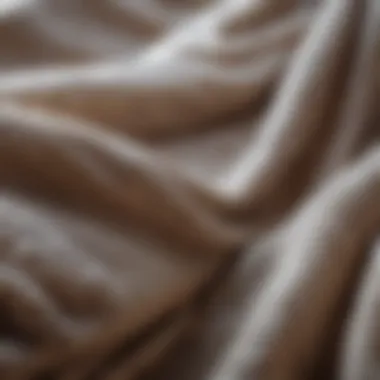A Guide to Hand Washing Delicate Fabrics Effectively


Intro
Hand washing delicates is an essential skill for anyone who values their clothing. Delicate fabrics, such as silk, lace, and certain knits, require special attention. By doing so, you not only prolong the life of these garments but also maintain their aesthetic appeal. Many factors come into play when it comes to this process, including water temperature, soaps, and washing techniques. Understanding these elements can significantly impact the longevity of your clothing.
This guide aims to demystify the hand washing process. It will cover the necessary materials, detailed methods, and environmental considerations. With the growing awareness around sustainability, taking proper care of clothing becomes even more pertinent. Your garments deserve the best care possible, and hand washing is an effective way to achieve that.
Design Inspirations
Trending Styles
When considering the care of delicate fabrics, understanding current trends can enhance the shopping and washing experience. Today’s fashion often features intricate details, such as beading or embroidery, which necessitate a gentle touch during cleaning. Such styles are not merely aesthetic; they represent an investment in quality. Delicate pieces can elevate any wardrobe when properly cared for. For instance, a silk blouse with fine lace neckline can be a staple if appropriately maintained.
Fashion enthusiasts should remain aware of how each garment can bring a unique character to their collection. It may be helpful to reference spring and autumn collections from designer brands, as these often highlight delicate fabrics. Knowing what to expect in terms of care is vital before making a purchase.
Color Palettes
Color also plays a pivotal role in fabric maintenance. Light colors can show dirt quickly, thus requiring more frequent washing. Darker colors may hide stains better but can fade over time with improper care. Choosing a color palette that suits your lifestyle and how often you want to wash your delicates can save time and effort. Consider opting for colors and patterns that complement your wardrobe. It's important to remember how color influences not just the fashion statement but also the care routine.
Maintenance and Upkeep
Seasonal Maintenance Checklist
To maintain delicate garments, creating a seasonal maintenance checklist is beneficial. This can help ensure that you consistently care for your clothing. Important considerations include:
- Inspecting for any signs of wear or damage.
- Checking for any stains that may need immediate attention.
- Reviewing your washing supplies, including detergents and garments' tags for specific care instructions.
Cleaning and Organization Tips
Effective cleaning practices are essential. Always prepare laundry by sorting delicates from regular items. This prevents any potential damage. It is also wise to keep delicates in a separate designated area, reducing the chance of accidental mishandling.
When organizing, consider using protective storage solutions. Cloth bags or specific garment bags can help maintain your items in their best state.
"Proper care of your delicate fabrics is not just about cleanliness. It's about preserving the story each garment tells."
Understanding the washing process enhances your ability to care for clothing profoundly. An approach that incorporates both cleaning and strategic organization can transform the management of delicate fabrics.
Understanding Delicate Fabrics
Understanding delicate fabrics is crucial when it comes to proper care and maintenance of garments. Different types of textiles have diverse properties, and knowing these can significantly affect how you handle and wash them. Properly caring for delicate fabrics can extend their lifespan, preserve their aesthetics, and maintain their functionality. This section will delve into various types of delicate materials, their key characteristics, and how to identify whether a garment is delicate.
Common Types of Delicate Fabrics
Delicate fabrics encompass a range of materials that require special attention. Some common types include:
- Silk: Known for its luxurious feel and sheen, silk is susceptible to damage from improper washing.
- Lace: This intricate fabric is often used for embellishments. It is easily torn or snagged.
- Chiffon: Lightweight and sheer, chiffon can become misshapen or damaged if not handled gently.
- Cashmere: Soft and warm, cashmere tends to pill and lose its shape when washed carelessly.
- Tulle: Commonly used in formal dresses, tulle is fragile and can tear easily when under pressure.
These fabrics often require gentle washing methods to avoid irreparable damage.
Characteristics of Delicate Materials


Delicate materials share several unique characteristics:
- Fragility: They can easily tear, stretch, or lose shape under stress.
- Absorbency: Many delicate fabrics tend to absorb water and stains more easily, making them prone to damaging substances.
- Sensitivity to Heat: High temperatures from washing machines or dryers can alter their structure and appearance.
- Dye Sensitivity: Many delicate fabrics are dyed using colors that may bleed easily, risking color loss during washing.
Knowing these characteristics can help you make informed decisions regarding the cleaning process.
Signs Your Garment is Delicate
Identifying a delicate garment is key to preventing damage. Here are some signs:
- Care Labels: Always check the garment's care label for specific washing and drying instructions. If it says "hand wash only," take it seriously.
- Weight: Lightweight fabrics often indicate delicacy. If it feels too light, it may need gentle care.
- Surface Texture: Textiles with a soft, smooth texture are generally more delicate than those with a robust profile.
- Ornamental Details: Beads, sequins, or other embellishments can signal that a garment is delicate. These additions often require more careful handling.
Being keen to these signs can prevent unnecessary damage.
The Importance of Proper Care
Understanding the significance of proper care for delicate fabrics cannot be overstated. When it comes to garments made from fragile materials, the choices we make during the washing and maintenance process directly influence their longevity and condition. Investing time and effort in caring for these items is not just about aesthetics; it is a crucial factor that preserves their structural integrity.
Extending the Lifespan of Your Garments
Delicate fabrics require special attention. By hand washing and adhering to suitable care methods, the lifespan of your garments can be effectively extended. Hand washing minimizes the risks of fraying, stretching, or fading that often occur with machine washing. Gentle handling reduces wear and tear on fibers. Additionally, using appropriate detergents further maintains the fabric’s integrity. It's beneficial to treat garments with care right from the outset, as initial attention can yield years more use of your favorite pieces.
Preventing Damage from Improper Washing
Improper washing techniques are one of the primary culprits for damaging delicate fabrics. Using harsh detergents or subjecting items to excessive agitation can lead to irreversible harm. Common damages include:
- Pilling: Small balls of fibers could form on the fabric surface due to friction.
- Color bleeding: Mixing colors or using the wrong detergent might cause shades to run.
- Fabric stretching: High spin cycles can distort shapes.
By adhering to proper hand washing techniques, you can significantly decrease these risks and maintain the visual appeal of your clothing.
Environmental Considerations
The impact of laundering on the environment is an important consideration. Hand washing conserves water compared to machine washing, especially when dealing with a few delicate items. Additionally, using eco-friendly detergents reduces harmful chemicals from entering waterways.
"Every small step can contribute to a larger positive change in our world."
Choosing to wash delicates by hand, along with selecting sustainable products, fosters responsible consumption habits and helps promote environmental well-being. Such actions reflect a modern understanding of caring for fabrics, which extends beyond the garment to include the planet.
Essential Tools for Hand Washing
Hand washing delicates properly is not merely about using gentle methods; it also involves having the right tools on hand. The tools you choose can significantly affect the outcome of your cleaning process. They help you achieve effective cleaning without damaging your precious fabrics. Therefore, knowing what to gather before starting is essential.
Recommended Detergents
The choice of detergent is crucial when hand washing delicate items. A standard laundry detergent can be harsh, containing chemicals that might harm sensitive fabrics. Instead, look for detergents specifically designed for delicate fabrics. Woolite and The Laundress Delicate Wash are popular choices among users. These detergents are formulated to clean gently while preserving the fabric's integrity.
Some prefer eco-friendly detergents, which are kind to both garments and the environment. Brands like Ecover and Seventh Generation offer options free from harsh chemicals. Always read the labels carefully. Select a product that suits both the type of fabric and any sensitivities you may have.
Tools and Accessories Required


In addition to the right detergent, several tools can enhance your hand washing experience. Gather the following items:
- A soft mesh laundry bag: Protects delicate garments from friction.
- A clean, soft sponge or washcloth: Ideal for gently scrubbing.
- A bowl or basin: Choose one that is deep enough to submerge the fabrics without crowding.
- A drying rack or clean towel: To help air-dry garments without stretching.
- Gloves: For those concerned with skin sensitivity or exposure to detergent.
These tools make the process easier and safer for your garments. They contribute to achieving the best results with minimal risk of damage.
Choosing the Right Washing Basin
The washing basin choice can influence how effectively you can care for your delicates. A plastic basin or a clean sink works well, but it should be spacious enough. You want to avoid overcrowding the items to ensure they can move freely in the water. Proper water circulation is crucial in the washing process to lift dirt and residues without scrubbing harshly.
Consider a basin with a flat base. This allows items to rest flat while soaking without any pressure points that may result from an uneven surface. Additionally, ensure the basin is clean and free from residues from previous uses. A thorough rinse before use will prevent any transfer of unwanted substances onto your delicates.
Remember, the right tools and preparation result in a successful hand washing session.
Having these essential tools ready can make a distinct difference in your hand washing experience. Pay attention to every detail to ensure optimal care for your delicate fabrics.
The Hand Washing Process
The hand washing process is fundamental to ensuring the longevity and integrity of delicate fabrics. This careful methodology not only prevents damage from traditional washing machines but also caters to the unique requirements of each garment. As many delicates can be easily compromised, understanding and implementing the right steps can result in garments that keep their form, color, and softness for years.
Preparation Steps
Before diving into the washing process, it is essential to prepare adequately. The initial steps set the tone for successful fabric care. Consider the following:
- Sort Your Laundry: Separate delicates from heavier items. This minimizes the risk of abrasion.
- Check the Care Labels: Always read the labels on your garments. This provides crucial guidance on washing instructions and temperature.
- Gather Supplies: Ensure you have everything at hand. This includes a gentle detergent specifically designed for sensitive fabrics, a clean basin, and possibly a towel for drying.
- Fill the Washing Basin: Use cool or lukewarm water as needed. Hot water can deform or shrink delicates.
Taking these steps ensures a smoother operation when it is time to wash.
Step-by-Step Washing Instructions
Washing delicate items can be a straightforward task if executed correctly. Here’s a succinct breakdown:
- Dissolve Detergent: Before placing garments in water, dissolve the detergent completely. This avoids uneven distribution and ensures all areas of the fabric receive proper care.
- Gentle Agitation: Submerge the items gently into the water. Move them softly without scrubbing. A light push and pull can help release dirt.
- Time Management: Allow your garments to soak for about 5-10 minutes. This time enables the detergent to break down any dirt or stains present.
- Rinsing: Carefully lift items out of the soapy water. Excessive twisting or wringing can damage delicate fibers.
By following these instructions, you maintain the fabric's original shape while effectively cleaning the garment.
Rinsing and Drying Techniques
Post-wash care is crucial for preserving the condition of delicate items. Here’s a concise guide to rinsing and drying:
- Rinse Thoroughly: Use cool water to rinse away detergent residue. Repeat as necessary until water runs clear.
- Press, Don’t Wring: When removing excess water, press the fabric against the basin's side rather than wringing. This reduces strain on the fibers.
- Drying: Lay delicate items flat on a clean, dry towel to absorb moisture. Avoid direct sunlight, which can fade colors.
- Hanging with Care: If hanging, use padded hangers to prevent stretching. Avoid metal hangers as they may leave marks on delicate fabrics.
Effective rinsing and proper drying are essential for maintaining the structure and appearance of delicate fabrics.
By applying the above techniques, you assure that your delicate garments remain in excellent shape, looking fresh and vibrant after each wash.
Post-Wash Care
Post-wash care is typically overlooked, yet it plays a crucial role in maintaining the quality and appearance of delicate garments. After the hand washing process, proper handling and storage significantly contribute to the longevity and integrity of these fabrics. By being mindful of the steps to take post-wash, you can preserve the beauty and functionality of your delicates.


Storage Solutions for Delicates
Storage of delicate items requires special attention. Proper storage minimizes fabric damage, keeps them stain-free, and ensures they retain their shape. Consider using breathable fabric bags instead of plastic, as plastic can trap moisture, which fosters mold and mildew growth. Organizing delicates by category will help you find them easily when needed. Items like silk, lace, and chiffon should be stored flat to prevent creases and stretching. Similarly, avoid hanging delicate dresses or blouses, as this can distort their shape over time. Using padded hangers is an excellent option when hanging is unavoidable.
Key Points for Storage:
- Avoid plastic; opt for breathable fabrics.
- Store flat when possible to prevent deformation.
- Use padded hangers for items that must be hung.
- Organize by category for easy retrieval.
Ironing and Steaming Tips
When it comes to ironing delicate fabrics, caution is essential. High heat can cause irreversible damage. Always check the garment's care label for specific instructions regarding heat settings. Use a low-temperature setting, or steam as an alternative to dry ironing. For extra protection, place a thin cloth between the iron and the fabric. This barrier helps to prevent direct contact and potential scorching.
Another effective method is using a handheld garment steamer. Steaming is gentle, versatile, and efficient for delicate items like silk. Hold the steamer a few inches away from the fabric to avoid over-saturating and damaging it.
When to Seek Professional Help
Sometimes, delicate items may require professional care. If a garment becomes heavily stained or is fragile in nature, consulting with a dry cleaning expert may be the best course of action. Additionally, fabrics such as velvet, cashmere, and embroidered pieces often need specialized expertise. Look for professional services that have gained strong reputations for handling delicate fabrics. Research local options well and read reviews before handing over your cherished items.
"If in doubt, it’s better to choose professional care for delicate fabrics than risk damage at home."
Being proactive in your post-wash care not only preserves the lifespan of your delicates, but also enhances your overall garment collection. Remember, each fabric has its unique needs, so being attentive to details can make all the difference.
Common Mistakes to Avoid
Understanding common mistakes is essential for maintaining the quality of delicate fabrics. These errors can lead to irreversible damage, affecting both the appearance and lifespan of your garments. Avoiding these mistakes not only preserves your delicates but also saves you money in the long run. Here are some pitfalls to be aware of:
Using the Wrong Detergent
Selecting the right detergent is crucial when washing delicate fabrics. Many detergents on the market contain harsh chemicals that can degrade fibers, cause fading, or create unwanted textures. Products like Tide or Arm & Hammer can be too abrasive for silks or lace. Instead, look for detergents specifically formulated for delicates. Brands such as The Laundress or Ecover provide gentle alternatives that are effective yet mild. Always check if the product is labeled as safe for delicate fabrics. Using the right detergent helps in maintaining the fabric's quality, ensuring that colors remain vibrant and textures stay intact.
Ignoring Fabric Care Labels
Fabric care labels are not just there for decoration; they offer essential guidance on how to care for your items. Overlooking these labels can lead to costly mistakes. For example, some fabrics may be hand wash only, while others might require cold water. Patterns like "Do Not Bleach" have practical implications for maintaining fabric integrity. If a label states to air dry, ignoring this instruction might shrink or distort the garment. Take time to read these labels before washing. Doing so will help you align your washing methods with the manufacturer’s recommendations, maintaining the fabric's longevity and appearance.
Overwashing Delicates
It is a common misconception that frequent washing keeps garments looking fresh. In reality, overwashing can cause significant wear and tear on delicate fabrics. Washing items like cashmere or chiffon too often can lead to loss of texture and shape. Generally, washing on a need basis is best practice. If the garment does not have noticeable stains or odors, consider simply airing it out for freshness. When you do wash, aim for a gentle cycle and limit your wash frequency. This helps retain the garment’s original structure, ensuring your investment in delicate fabrics lasts longer.
Ensure you're mindful of these common mistakes to protect your delicate items effectively. Taking these considerations into account is crucial for proper fabric care.
Culmination
Hand washing delicates is more than just a chore; it is a commitment to maintaining the quality and longevity of sensitive fabrics. The conclusion of this guide ties together the essential knowledge acquired about handling delicate garments. Readers are now equipped with techniques, tools, and a better understanding of the significance of correct washing methods. Emphasizing mindful care, one can appreciate the benefits that arise from proper hand washing.
"The integrity of a delicate garment lies in the care it receives; investing time in hand washing is an investment in its future."
Summary of Key Points
In this article, we explored the entire process of hand washing delicates. The primary elements include:
- Understanding Different Fabrics: Knowledge about delicate materials helps in recognizing their unique needs.
- Importance of Proper Cleaning: Hand washing can greatly extend the lifespan of delicate fabrics while preventing damage.
- Essential Tools and Products: Certain tools and detergents were recommended to ensure effective cleaning.
- Detailed Hand Washing Process: Step-by-step instructions guided readers through each stage of the washing process.
- Post-Wash Care: Insights on storing, ironing, and when to seek professional help ensures your garments are well cared for.
- Common Mistakes to Avoid: Awareness of pitfalls, such as using harsh detergents or overwashing, can improve the outcomes.
Final Thoughts on Hand Washing
Hand washing delicate items should be considered not merely a task but rather a refined practice. The need for careful handling cannot be overstated. Homeowners and fashion enthusiasts alike should take the time to understand each step, leading to benefits beyond surface-level cleanliness. Proper care nurtures the fabric’s fibers, allowing garments to retain their aesthetic appeal and functionality. Over time, this commitment pays dividends, fostering a greater appreciation for quality clothing. It is hoped that this guide not only serves as a manual for effective fabric care but also as inspiration for deeper understanding and respect for delicate garments.







